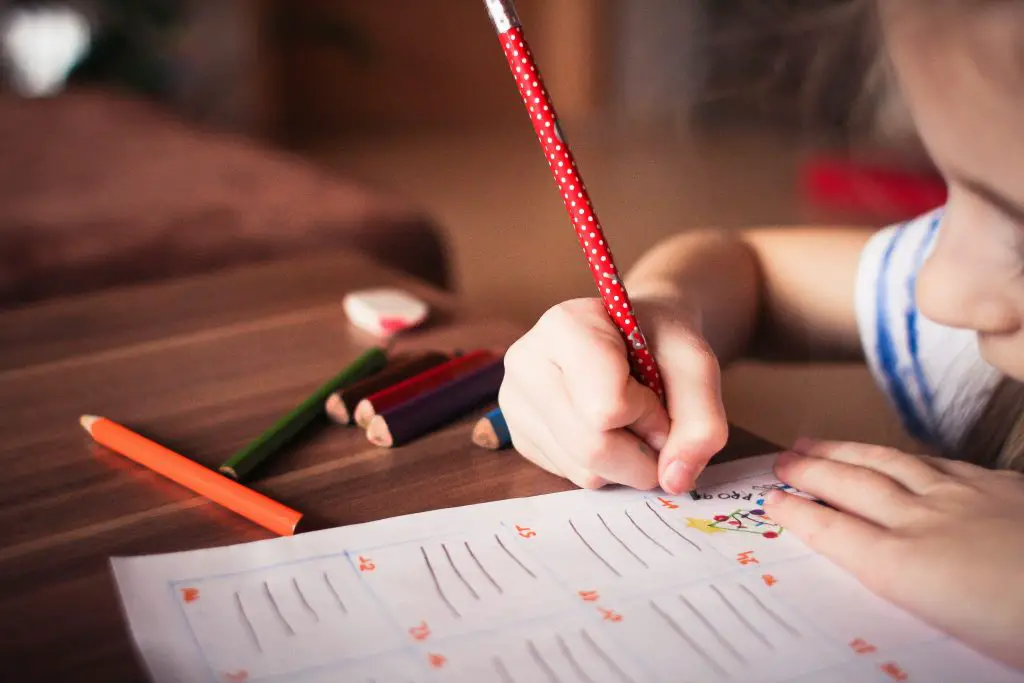Laura Bush – a former American educator, First Lady of the United States during the presidency of George Bush, in the White House Summit on Early Childhood Cognitive Development once said that the development of children between birth and age five is the key that leads to a successful life in the future.
Apart from reading, listening and speaking, writing is considered a powerful form of communication.
Children should know how to write properly to become a good communicator in the future.
Therefore, they need to develop a range of writing skills, from recognizing the texts to producing and presenting them to other people.
Although kids develop at different rates, most of them may learn to write their name at kindergarten (3-4 years old)
Knowing how to write their name is one of the literacy milestones that children reach in their early life.
Children who know more letter names at kindergarten would set themselves a solid background to read and write in their future education.
Teaching your child to write their name is an indispensable job to be done as a parent. However, getting there takes time, patience and effort.
Initially, you need to know whether your child is ready to write or not, since letting it a natural thing that comes to a child would make it easier for him or her to acquire knowledge in writing skills.
Certain behaviors will start to appear such as:
- They produce Intended drawings instead of random marks and scribbles and become fond of individual letters.
- They orientate things the proper way, such as not hanging a picture upside down.
- They can copy shapes and lines.
Those mentioned above are clues which indicate that your child is willing to write.
Below are some steps to help your child approach and hone their writing skills, starting with how to write their name:
1. Helping them to recognize their name
This would be a solid step for children before they learn to write their names.
Rather than tearing apart the process of name recognition and name-writing, they are built on each other so that children can learn in chronological order.
Besides, children can be more confident and independent in the classroom as they can find their name tag or locker without seeking help from teachers.
As parents, there are many activities you can arrange to support your child to recognize their name:
- Let your child be surrounded by letters, which may trigger their curiosity and attention.
- You can do this by placing their names printed on their toys, bags, hats, bottle, lunch boxes and photos to help them grow accustomed to the letters.
- You can also hang pictures on the wall that display their name in both lower and upper case letters to benefit children from distinguishing these two forms of letters. While upper case letters are only used to begin a sentence or somebody’s name, lower case letters are those account for the majority of the letters.
- Another way is to put their name on the bedroom door with playful patterns and bright colors to intrigue your child.
By implementing these methods, constantly and densely, your child will begin to identify their name and claim ownership of it.
For preschool teachers, you can refer to Vanessa Levin’s Top 20 Activities to Use with Student Names, which would help children not only recognize their name but also their classmates’.
2. Teaching them to spell their name

After getting used to his name, a child should learn how to spell it properly because he needs to acquire it in the verbal form before moving to the next stage.
Many parents find it possible to come up with a song or cheer and sing their child’s name to the tune of the song.
For example, for the name Roger, you may sing R-O-G-E-R and follow by catchy or funny lyrics to instill into your child’s head and make him remember it completely.
Additionally, you could write down your child’s name and say each letter out loud for him. Make sure your child can catch up with the process by doing it slowly and clearly.
After that, ask your child to say each letter as you write their name on the paper. Initially, he can mix some letters up, but all you need is to be patient and don’t worry.
You can also approach this step more playfully by organizing games for your child to learn how to spell his name.
Since learning can be boring sometimes, keeping your child to concentrate on games and fun activities would be a helpful tip. Check out this video from Play to Learn Preschool to know more about how to teach kids to spell their names.
If you want these spelling lessons to be more creative, try 5 Creative Ways to Teach Kids to Spell Their Name by Scholastic, which they divide different activities based on a child’s age.
3. Teaching them to write their name
Teaching your child to write means that you are also developing their fine motor skills.
Fine motor skills involve the use of the smaller muscles of the hands, including how to use a pencil.
These skills have a huge impact on the development of a child. To find out more about fine motor skills and their effects, have a look at this article from Kid Sense.
Therefore, it is crucial for your child to learn how to grip a pencil properly so that they can write their names easier. The perfect way to hold a pencil is the “tripod grasp” which involves the thumb, index and middle finger.
It is also recommended that handwriting should be a fun activity for children so that they will not feel like they are being forced to practice writing.
Below are some tips that parents and preschool teachers can try to help children honing their writing skills:
- Tracing over dotted lines: you can write out your child’s name in papers or print it in large font and with outlines.
By doing this, your child can follow and stick to the patterns of the letters that form his name.
Remember to remind your child of the principle of writing, starting from top to bottom and left to right with an aim to make a habit of writing neatly and logically.

You can utilize a dry erase board as an alternative to paper so that your child could have more chances to practice handwriting without wasting any piece of it.
- Experimenting letter formation: it is more interesting when children are exposed to a multisensory approach and hands-on experience in writing.
Apart from pencils, clays, and paints, even candy can act as materials to form letters.
Therefore, children can practice writing their names and have fun at the same time, which makes them remember their names more quickly.
- Starting with upper case letters: it is believed that kids find it easier to memorize and copy capital letters.
First, teaching your child to write his name in capital letters until he has mastered it, then slowly fostering lower case letters.
They also need to know that only the first letter of their name is written in capital and the remainings are lowercase letters.
- Trying the scavenger hunt: let’s make it a game for your child to help them practice both spelling and the order of the letters in their name.
It is easy to play the game even when you are out and about. Provide verbal instructions to your child when he is finding his name and explain individual letters clearly and slowly.
- Complimenting when they make progress: your child deserves to be applauded when he writes his name in a correct way.
Parents should praise them continuously to give their children more motivation to practice writing skills and encourage them to improve.
As a result, they will feel a sense of pride and be more confident in their abilities.
For more ways to develop your child’s handwriting, check out these suggestions by Hand on As We Grow.
In conclusion, one of the first steps in a child’s writing skills is to learn how to write their names. It is also considered a great achievement in their early life.
Not only this would prepare them for the first day of school, but it also assists them in other essential skills such as reading or speaking.
As parents or even preschool teachers, it is a pleasure to provide children with the knowledge and the skills they need to develop.
We also have the responsibility to nurture our children to become successful writers and learners.
We hold the key to the academic development of the youngest generation, whose future is wide and bright.
Starting with teaching children to write their names is the key to contribute to the growth of them.
They can lose concentration or mess up with those strange letters at first, but all you need to do is to spend more time with them and be patient and praise them as much as possible.
Make them believe in what they can do and give them more motivation so that they could always strive for the best and become successful people in real life.





